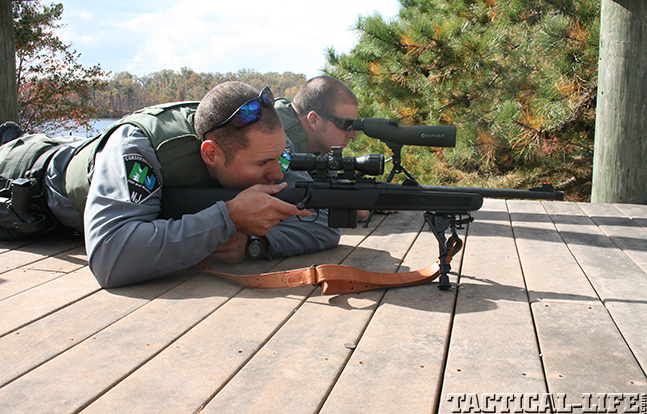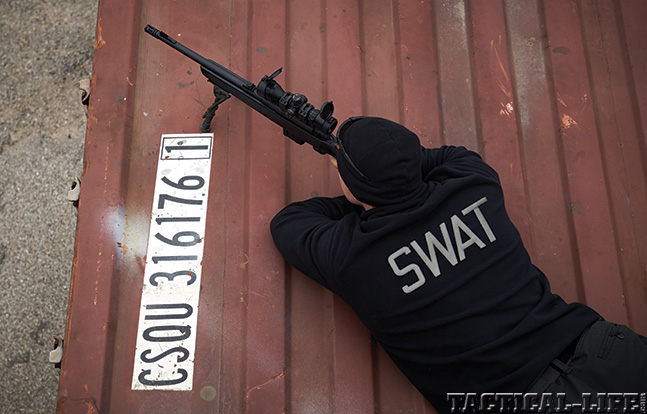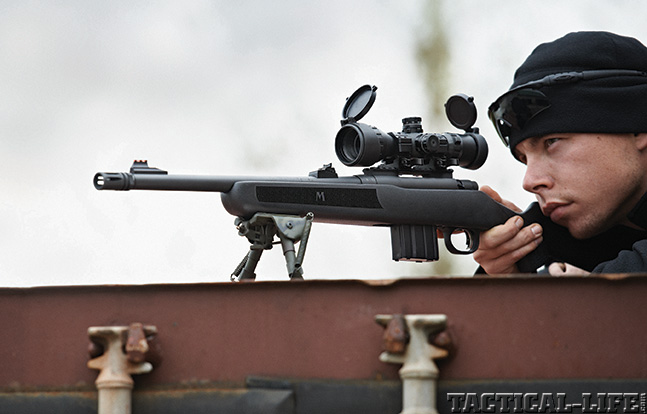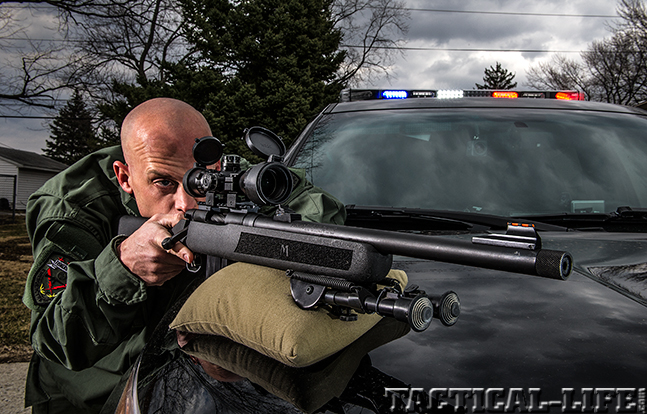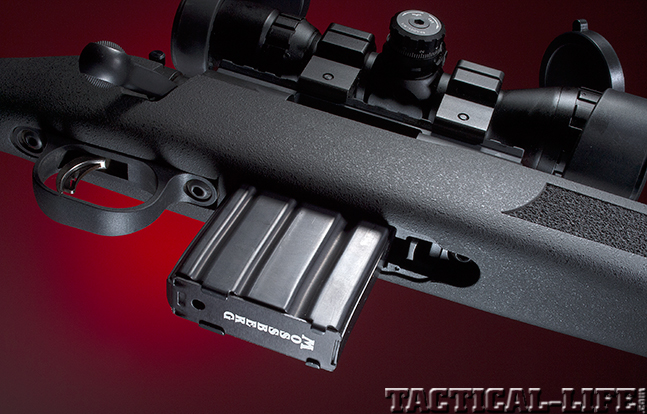Thirty years ago, rifles within the law enforcement circle were pretty rare commodities. There were a few AR-15s and precision rifles in the mix, but by and large rifles were pretty much limited to SWAT operators. Fast-forward to the present day, and it’s pretty clear that the concept of the “patrol rifle” has caught on in a big way. Forward-thinking administrators have come to the realization that, on occasion, a rifle is the best tool for the job and have equipped their officers accordingly. When time is of the essence, there is simply no time to wait for the arrival of a special team.
From an historic perspective, rifles were widely used by law enforcement through the Great Depression. In the years following World War II, the shotgun’s popularity soared, and it became the overwhelming choice in shoulder-fired police weapons. The paradigm has once again shifted, and the rifle has now regained quite a bit of lost ground.
Currently, the hands-down favorite rifle for the patrol officer is the AR-15 and its many clones. In fact, it is so popular that it has become a notable event when I encounter a law enforcement officer in one of my training classes with something other than an AR-15. With that said, I thought it was a little unusual when Mossberg introduced a bolt-action 5.56mm rifle dubbed the MVP Patrol.
Advertisement — Continue Reading Below
Can a bolt-action rifle encroach on the turf dominated by the Stoner-designed AR platform? After taking an MVP Patrol on an extensive test-drive, I feel it has much to offer. It may not fill the exact same niche as a military sporter, but it does some things exceptionally well. Let’s take a look and see what the Mossberg MVP Patrol is all about.
Gun Details
The MVP Patrol is a relatively compact, bolt-action rifle with a detachable box magazine. With a total length of just over 35 inches, it is handy enough for a quick exit out of the patrol vehicle. Its medium-weight, bull barrel measures 16.25 inches long and features a 1-in-9-inch rate of twist. Unloaded, the MVP Patrol tips the scales at 7 pounds.
Advertisement — Continue Reading Below
This rifle is based on Mossberg’s earlier 4×4 series and incorporates a number of positive attributes. I grew especially fond of the adjustable Lighting Bolt Action (LBA) trigger, which is user-adjustable through a 2- to 7-pound range. A most unique feature is a flipper in the middle of the trigger that must be fully depressed in order to fire the rifle. This setup is reminiscent of the trigger on my Glock pistol and may prevent an unintentional discharge, especially when the trigger has been dialed into one of the lighter settings. In any event, the MVP’s trigger pull is superior to many rifles that cost much more.
A drop/push bolt ensures reliable feeding from the magazine to the chamber. Single-loading rounds by dropping them through the port was also bug free. The spiral-fluted bolt was easy to manipulate, and it can be removed for cleaning by pushing a lever on the left rear portion of the action. A two-position safety lever sits on the starboard side.
“When time is of the essence, there is simply no time to wait for the arrival of a special team.”
Advertisement — Continue Reading Below
The stock appears to be made of birch hardwood with a black finish. Both the forend and pistol grip have an aggressive, textured surface for a positive hold. The length of pull is 13.25 inches, which proved just about right for this shooter. The stock is equipped with a rubber recoil pad and a pair of studs to affix sling swivels is all part of the package.
The barrel has a 110-degree tapered crown, and the muzzle is threaded to accept accessories. Both a knurled cap and an A2-style flash suppressor are included. For law enforcement applications, I really like the ability to affix the flash suppressor for night operations. One could also mount a sound suppressor for good effect.
End-users can opt for a MVP Patrol with iron sights or a scope. Standard items include a rear sight, adjustable for windage and elevation, that is paired with a red fiber-optic front sight. My sample also came equipped with a 3-9x32mm scope made by UTG. This scope packs a lot of features, including an illuminated mil-dot reticle. A Picatinny rail is also standard on the MVP Patrol package. Mossberg ships the MVP with a 10-round, AR-15-type magazine. I fed my sample rifle with some of my 20-round duty magazines, and they fed flawlessly.
Advertisement — Continue Reading Below
Range Time
I have had considerable experience with Mossberg shotguns, but the MVP Patrol would be my first experience with the firm’s bolt-action rifles. Quite frankly, I had no idea what to expect. Prior to heading off to the range, I added a leather sling and a Harris Bipod to the test rifle.
In fairly short order, I had the MVP Patrol sighted in. After a quick warm-up consisting of busting up some dirt clods on the range berm, it was time to get serious and check out the rifle’s accuracy potential. I fired a series of five-shot groups from a stable rest at targets set at 100 yards. I tested the MVP with five different .223/5.56mm loads.
Advertisement — Continue Reading Below
To cut right to the chase, the results exceeded my expectations. Several loads averaged just a tad over an inch, with a few five-shot knots coming in at less than 1 minute of angle (MOA). The best-performing load was Federal’s 55-grain Sierra GameKing BTHP, which averaged a tight 1.25 inches. The Hornady 40-grain TAP and Federal TRU 55-grain Nosler Ballistic Tip loads also turned in consistently tight groups. All of these loads are ideal for law enforcement applications.
“The MVP Patrol is one of those rare birds that does exactly what it is supposed to do.”
The MVP’s short 16.25-inch barrel still provided plenty of burn time for the .223 test loads to reach their full potential. The light Hornady TAP load screamed downrange at nearly 3,300 feet per second (fps), while my preferred 55-grain loads exceeded 2,900 fps. No matter how you cut it, the MVP Patrol delivers the goods.
Advertisement — Continue Reading Below
At a later session, I kept busy by hammering away at steel reactive targets set between 50 and 200 yards. This, too, proved to be a snap. Practical accuracy proved to be excellent shooting from either prone or sitting positions, and the distances I fired from certainly covered just about anything that could be anticipated in civilian law enforcement.
Final Thoughts
In law enforcement, we often associate bolt-action rifles with the precision marksman/counter sniper rather than a patrol officer. As outlined earlier, most patrol rifles tend to be semi-auto designs, and one may wonder where a manually operated bolt-action fits into the mix.
Advertisement — Continue Reading Below
To get a better idea, let’s consider the attributes of the MVP Patrol. Without question, it is a handy, exceptionally accurate rifle with a very user-friendly trigger. The fact that it takes AR-15 magazines can only broaden its appeal. Did I mention cost? The MSRP of the Patrol Rifle is far less than a quality AR-15. Sure, you might be able to buy a hobby-grade AR at a similar price, but I doubt its shooting qualities would match those of the MVP Patrol. Spend a few more bucks for the package with the UTG scope and you will be well ahead of the game.
In some areas, a bolt-action rifle for patrol might be an easier sell to the town fathers than a military sporter. We might not agree with the principle of “scary” versus PG-rated rifles for law enforcement, but I can tell you from experience that this often weighs into the equation. The realty of the matter is that in most real-world scenarios where a patrol rifle has been used, the situation has been resolved with one shot. Rural officers will also like the ability to reach out considerably farther than their pistol or shotgun allows.
The MVP Patrol is one of those rare birds that does exactly what it is supposed to do. Its practical accuracy was every bit as good as the 5.56mm bolt action I maintained for many years on my job, and the MVP Patrol proved much easier to hump around. This is a big plus when bailing out of vehicles or getting into odd positions in tight places.
Advertisement — Continue Reading Below
Even if I had tried to find a fault with the MVP Patrol I would have little to offer in the way of criticism. To my thinking, I wish the magazine release were a little longer to facilitate operation in cold weather or with gloved hands. A high-tech synthetic stock would no doubt make the total package lighter, but it would also drive up the cost. Some users may prefer to mount the optic of their choice rather than the UTG scope included in the package. I had no issues with the UTG 3-9x32mm scope during testing, but I felt the mil-dot reticle was a bit coarse for my taste. In any event, it may prove more than adequate for its intended role.
In the near future, Mossberg plans to market the MVP Patrol in .308 Winchester and 300 AAC Blackout. A copy in 300 AAC Blackout may prove to be the ideal balance between rifle and cartridge, and when it appears, you can follow my vapor trail to the nearest gun shop.
For more information, visit mossberg.com or call 800-363-3555.
